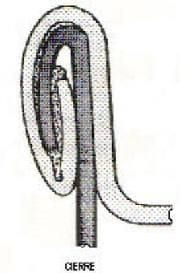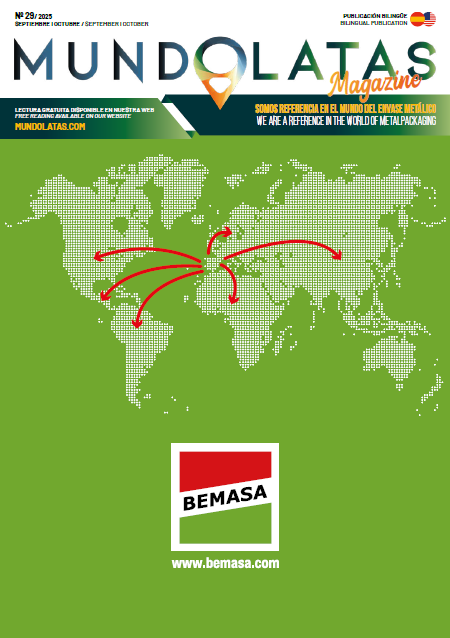| TERM | MEANING |
| HEAD (CLOSER) |
Set of mechanisms of a closing machine, including the mandrel, the ejector and the trolleys, which carry out the closing operation. A seamer can have one or more seaming heads. |
| FALL IN THE UNION (CLOSING) |
Deformation (or undulation) in the radius of the lid hook (lower part of the clasp) that originates in the area coinciding with the side seam of the body. It is caused by the over thickness of metal in this area. It must not exceed a certain value. |
| BASE BOX | Average unit of tinplate per surface area. It is equal to the surface of 112 sheets of dimensions 20X14 inches or what is the same, 31.360 square inches and is equivalent to 20.23 square meters. It is mainly used in the American market. 1 base case= 1.1201 European base case= 0.2023 sitas |
| EUROPEAN BASE BOX | Average unit of tinplate per surface area. It is equal to the surface of 100 sheets of dimensions 20X14 inches or what is the same, 28,000 square inches and is equivalent to 18.06 square meters. It is mainly used in the European market. 1 European base case= 0.8928 base case= 0.1806 sitas |
| SIZE (TINPLATE) Thickness tinplate Thickness tinplate |
See tinplate thickness |
| CAP (AEROSOL) Cap (Aerosol) |
A part usually made of plastic that covers and protects the actuating valve in an aerosol-type container . It is usually equipped with nails that allow it to be fixed to the top of the container, either on the closure of the dome or on a projection of the same. |
| LOAD (VARNISH) Film weight |
See film weight. |
| SHEET FEEDER Sheet Feeder | View sheet feeder |
| RACE (PRESS) Cursa Route |
Displacement of a press carriage. Its value is given by twice the magnitude of the crankshaft elbow. Although this is the most usual meaning of the term, it is also used to designate the path of any organ of a machine with reciprocating motion. |
| CARRIERS
Rulinas Moletas Closing rollers |
See rollers. |
| (PRESS) Charriot |
This area of the press is equipped with a reciprocating motion that moves the moving part of the die or working tool, thestroke is given by the crankshaft. |
| THERMOPLASTIC CEMENT- TICO Thermoplastic glue |
Sealing resin that is applied melted (in pasty state) on the inside of the side seam of the agrafados cans to make it leak-tight. Its use is limited to containers that are intended for products that do not undergo a heat sterilization process (for example: paints, oils, etc.). |
| CLAMP (DIE) Die base Sufridera |
See matrix base. |
| WAX
Paraffin wax |
See paraffin. |
| CLOSER
Sertidora |
Machine that performs the closing. They are available for empty cans (rotating) and full cans in canneries (fixed). |
| CHROME PLATE
Sn free steel TFS |
Tinplate-like material in which tin has been replaced by chromium. It is made up of a base steel sheet coated on both sides with a layer of chrome and on top of this, a layer of chrome oxide. It has a metallic bluish gray color and in relation to tinplate has certain limitations in its use, for example it is not weldable and its handling is more delicate. |
| CHARRIOT (PRESS) Trolley |
View cart. |
| CLOSING
Sertido |
Joining the lid (or bottom) to the body by means of a crimping and flattening operation between the curl of the bottom and the flange of the body. It is usually carried out in two operations, thus obtaining the hermetic seal of the container. It contains five overlapping thicknesses of tinplate, three belonging to the bottom and two to the body. |
| SNAP LOCK | A way of covering a container by means of a lid fitted with a skirt that fits into the mouth of the body on the outside. It is not an airtight seal and is used for presentation packaging: chocolates, pastries, etc. |
| KEYPIPE (PRESS) |
Shaft equipped with two elbows, which transforms its circular rotary movement into a rectilinear one by means of a connecting rod. The part that receives the rectilinear movement is the press carriage, which is supported on bearings and its ends receive other parts of the press such as the brake, belt feeder drive, etc… |
| SCISSORS
Cutter Scissors |
Machine that cuts metal sheets into pieces by means of blades that can be scissor-shaped or circular. |
| CIRCULAR SHEAR
Circular cutter Circular scissorsen |
Shear that uses pairs of circular blades and cuts the metal by rotating them. |
| DOUBLE SCISSORS
Double cutter Double scissors |
Machine composed of two shears joined by an automatic transport system that allows to make sequences of cuts perpendicular to each other. |
| SCROLL SLITTER
Scroll cutter |
Shear with “scissor” type blades in a zigzag pattern that enables cutting of the material in this configuration. It is used in the manufacture of round or oval caps and achieves significant savings in raw materials. |
| CODING MACHINE
Marker |
Machine that marks a code on the container. The marking can be carried out by ink printing or die cutting . A typical example is the marking of the filling date on the container. |
| CODE
Brand |
Legal text marked on the filled container. Usually includes the date of filling |
| SEALING GLUE | Special adhesive formerly applied to the flanges of industrial (non-sterilizable) container bodies to obtain an airtight seal without the need to apply compound to the lid. It was put on the eyelash by means of a roller impregnated with this glue after the eyelashing operation. Its use is very limited at present. |
| THERMOPLASTIC GLUE
Thermoplastic cement- tico |
See thermoplastic cement |
| “COMMAS” IN SOLDADU- RA ELECTRICAL |
Empty spaces in the form of “comma” that can be found in the interior of the electric weld – in the side seam –. These are “spits” that are produced by excess heat in the process, generally caused by poor cooling of the welding wheels. They are very dangerous as they can lead to perforations in the container. |
| COMPOSITE
Rubber Gasket |
Elastic sealing material that is deposited on the inside of the flange of the lid to ensure the tightness of the container closure. It is applied in a liquid state and then solidifies, requiring a baking operation for certain types (water-based compounds). |
| BASE COMPOUND WATER |
Type of compound in which the sealing elements are basically dissolved in water. Requires heat input (oven or heater) for the evaporation of the same once it has been applied. |
| BASE COMPOUND SOLVENT |
Type of compound in which the sealing elements are located basically diluted in a chemical solvent. This solvent is evapo- The temperature of the water at room temperature and does not require the application of heat. for the compound to dry once applied. |
| CONE (AEROSOL) Copela Dome |
See dome. |
| CONTAINER (LITHOGRAPHED) Grill |
Support of metal rods that collects and transports the metal sheets to be dried in an oven after having been varnished or lithographed. They are mounted on a conveyor chain occupying the entire length of the drying oven. |
| SOLIDS CONTENT | Quantity of solid particles (expressed in %) of a varnish or of a compound in liquid state, before its application. |
| COUNTER WELDING MACHINE
Welding machine |
See welding machine. |
| COPELA
Cone Dome |
See dome. |
| CORDINGS
Lacing Ribs |
Ribs parallel to each other and normally perpendicular to the axis of the body of a container that are made on it to increase its resistance to overpressure or internal vacuum to which it may be subjected during processing. They allow the thickness of the tinplate to be reduced compared to a smooth-walled container of equal strength. |
| CUTTER
Shear Scissors |
See shear. |
| CIRCULAR CUTTER
Circular shear Circular scissors |
See circular shear |
| SCROLL SHEAR
Scroll shear |
See scroll shear. |
| CUT | The operation of sectioning a sheet of metal perpendicular to its faces. The resulting edge is also called this. The machine that performs this operation is called a cutter. |
| SIDE SEAM Side seam | Strip (generatrix) where the two ends of the developmentof the body are joined once it is formed. This joint can be made with different technologies: electric welding, agrafado, overlapping… |
| CUATRICROMY (PRINT) |
Basic printing system in which the full range of colours is obtained from the three basic colours (red, yellow and blue) plus black. |
| CUBETA | Area of the lid (or bottom) in the form of a cavity, defined by the inner vertical side of the closure and the horizontal panel of the same. This recess houses the locking mandrel. |
| BLADES | Cutting tools for shears. |
| THREAD COUNT (Lithography) |
Small magnifying glass mounted on a stand used to check lithographic quality. |
| BODY | Part or side wall of the container. It can have a cylindrical, prismatic or other shape. Determine its height. |
| SUMMIT (CLOSING) |
Rounded upper closure area. |
| DOME (AEROSOL) Cone Copela |
It is given this name on an aerosol container to the top of it, as it has a configuration reminiscent of this shape. It takes the place of a lid on a normal container. It has a hole generally of 25.4 mm. (one inch) diameter, positioned in the center, where the valve is fixed. It is also called a cone. |
| CURE
Baking Baking Polymerizing Drying |
Curing of a varnish is understood as the process of drying or polymerisation of the varnish in an oven. This word is also used to designate the baking of compound in lids. |
| CURLING
Shaved Curl Curly Curling |
See curl |
| CURLING MACHINE Straightener Curling iron Straightener |
See curling machine. |
| CURSA (PRESS) Race Route |
Currently or previously attended : See career. |




